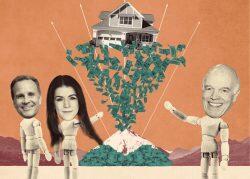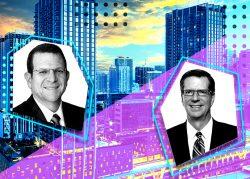Developer Chaim Cahane bought a development site in Miami’s Wynwood for $6.4 million in December. Three weeks later, a broker called him with an unsolicited all-cash offer: Flip it for 75 percent more.
Then, in March, Cahane’s Forte Capital partnered with investor Jon Krasner to buy a separate Wynwood site from East End Capital for $10.8 million. After closing on that site, they turned down an offer to flip it for a 30 percent gain.
“Every day I’m getting calls to sell,” Cahane said “It’s ridiculous.”
The cost of land and the pace and volume of deals are soaring in South Florida.
The market is so hot that major multifamily sales have become a dime a dozen, and single-family homes are referred to as collectors’ items. At the same time, developers are rolling out dozens of new projects, and selling or leasing them up quickly. Wealthy out-of-staters have “discovered Miami,” pumping up prices of commercial and residential real estate. To those buyers, the city is still a bargain, brokers say.
Miami’s urban core, including Edgewater, Wynwood, the Arts & Entertainment District, downtown and Brickell, has recorded over $1 billion in land sales over the past two years, according to Real Capital Analytics data provided by Colliers International South Florida. In Edgewater, eight development sites traded for more than $185 million last year. That marks a 529 percent increase in sales volume compared with 2020, and a 141 percent increase compared with 2019.
While industry experts are quick to point out that oversupply isn’t yet a concern, record pricing coupled with rising interest rates and inflation could send the market into a tailspin, they say.
“This bubble is about prices getting too high,” said Craig Studnicky, CEO of Aventura-based brokerage ISG World. “What’s happening with prices is obnoxious. How do young people move here? They can’t afford to anymore.”
Sticker shock
In 2019, prior to the pandemic, 24 development sites in Greater Downtown Miami sold for more than $315 million, or about $16 million per acre, according to the Colliers data. Last year, 34 properties traded for over $808 million in the same area, for a price per acre of about $19 million. On a dollar volume basis, that’s an increase of 155 percent in three years.

Attorney Keith Poliakoff (Government Law Group)
“A lot of people believed [prices] would hit a wall and not continue to escalate, but all we see are continual new highs for sales of properties,” said attorney Keith Poliakoff, of Government Law Group.
“If we can’t get [costs] under control, if the rents don’t catch up, and people’s incomes don’t catch up… We may be entitling projects three years from now, which happened before when the economy collapsed in 2009,” Poliakoff said. “A lot of those projects we approved just sat in building departments and didn’t move until the economy picked up again.”
When the pandemic first hit South Florida, there was an immediate slowdown in commercial real estate — until demand quickly returned last year.
Take the sale of the Midas store at 2140 Northeast Second Avenue in Miami’s Edgewater neighborhood. Prior to Covid, the listing broker, Miguel Pinto, said he “had a really, really hard time” trying to sell it.
“I couldn’t give it away,” said Pinto, who is broker and owner of Apex Capital Realty. Then, in February, Brooklyn-based Heritage Equity Partners paid $6.3 million for the property, home to a store that was built in 2019. Heritage, led by Toby Moskovits and Michael Lichtenstein, plans to tear it down and build an apartment tower on the site. Land costs typically account for 10 to 15 percent of a project’s budget.
Today, Pinto said it could “very easily flip” for over $400 per square foot. It traded for $283 per square foot.
“There’s been a crazy appetite from developers wanting to enter the market,” who are betting on rents and demand for housing continuing to rise, he said.
Some local developers are selling land on which they planned to build because the offers are just too good to pass up.
Read more


On Fisher Island, an exclusive residential enclave that is accessible only by boat or helicopter, developer Heinrich Von Hanau is in contract to sell the last condo development site on the island. The buyer is a partnership led by the Related Group and billionaire Teddy Sagi, paying what is expected to be a record price, according to sources.

Broker Mitash Kripalani (Colliers)
The thinking: Prices are still on the rise, and if a developer passes on a purchase, it could eventually sell for 20 percent, 25 percent or 30 percent higher, said Colliers broker Mitash Kripalani.
“Yes the price is high, but there is so much demand,” Kripalani added. “Most of the buyers paying top dollar are a lot of new-to-market developers. “If you’re a local buyer who was buying in Miami five to 10 years ago, you’re experiencing sticker shock.”
Developer Harvey Hernandez locked in a purchase price for the Brickell site of his Lofty project prior to the pandemic, and closed on his $50.5 million acquisition in October. He said he could sell it for more than double that in today’s market.
“People have come to us and tried to buy it from us, but we’re not in the business of selling [land],” he said. Lofty is nearly 90 percent reserved after launching sales in late 2021.
Chart of Greater Downtown Miami development site sales volume (Credit: Adam Farence)
“Developers coming into this market are paying for speed and paying for premium pieces.
They are looking at the market differently,” Hernandez said. “If you’re coming from New York, Chicago, Los Angeles you might see [Miami, where] you can sell for $1,200 a foot as a huge bargain.”
Brokers are using that in their sales pitches.
“All day long, we’re knocking on doors, we’re cold-calling people,” Kripalani said. “We’re chasing our sellers who we know haven’t transacted in a while.”
A dangerous game
The party line for developers is that they are monitoring construction costs (up 30 percent to 35 percent, but that depends on who you ask) and supply chain issues. They say they are locking in pricing on appliances and materials wherever possible, and so far those increases have been offset by gains in rents and home prices.
“The supply chain is still making it incredibly difficult to buy appliances and goods. The price of steel and wood varies dramatically,” attorney Poliakoff said. “What I get worried about is construction prices haven’t seemed to hit the top.”

Lender Aaron Kurlansky
Interest rate spikes are beginning to slow deals down. Buyers who were bidding on 10 properties are now bidding on two, said lender and broker Aaron Kurlansky, principal of Sheridan Capital and FM Capital. Rent growth projections are also being adjusted. Even on the residential front, some sellers of single-family homes are reducing their prices.
“With the rates rising, it’s really where on a deal previously you had 20 buyers, now you have five or six. It takes a lot of people out very, very quickly,” Kurlansky said. “We’ve definitely seen a little more prudency in the market.”
But developers are optimists who will push the market to its limits before pulling back.
In some cases, buyers are closing on land without taking the time to understand a site’s zoning. And because costs have surged, developers looking to increase the density of their projects have flooded law firms specializing in land use, zoning and entitlement work, Poliakoff and other attorneys say.
“There’s a maximum amount a unit can rent for or sell for,” Poliakoff said. “To be able to pay the higher prices, [developers] have to seek government approval to increase the density of these properties to spread out that purchase price. Long gone are the days where you could pay $25,000 to $35,000 per door for a new development site.”
He cited an example of a property owner who obtained entitlements for a 55-unit apartment project on a site two years ago in order to increase the property’s appeal. A prospective buyer recently told the owner that if the density could not be increased to 85 units, the numbers wouldn’t work and the deal wouldn’t happen, Poliakoff recounted.
New Yorkers and other out-of-state developers are lured by few regulations and the lack of state income tax in Florida, but once they arrive, some are in over their heads, unfamiliar with the building materials that should be used and how local governments work, attorneys say.
Government Law Group’s developer clients are all seeking more density on $2.5 billion worth of projects, Poliakoff said, pointing out three developments backed by New York-based real estate investment trusts that are developing for the first time in South Florida.
“All three are paying more than I have expected someone to pay, but in all instances they feel that the market will continue to go up, and as such they see that the rent today is not going to be the rent when they finish construction two years from now,” Poliakoff said. “I always say that while developers can profit handsomely, it also has enormous risk.”
Major multifamily landlords, who have arrived in South Florida in droves, are now moving into ground-up development because the investment sales market is overheated.
“All of them today have told us the deals they would normally buy are so overpriced, they are unable to make their numbers work,” Poliakoff said.
Pinto of Apex said that buyers have to pay less for land unless construction costs fall.
Institutional buyers have inundated the market, attracted to huge gains in rent growth. Miami led the country in rent hikes during the pandemic, with the median monthly apartment rent rising 58 percent since March 2020 to nearly $3,000, according to a recent report from Realtor.com.
Multifamily rents in Edgewater are at about $3.50 per square foot, according to Pinto. And buyers are underwriting deals with rents at $5 a square foot, two to three years from now.
“Will it get to that point? Maybe. I think people are playing a dangerous game,” he said, referring to rising rates, construction costs and inflation. “There’s a huge demand, and then a culmination of things from a macro perspective that can make the whole sentiment go south.”
